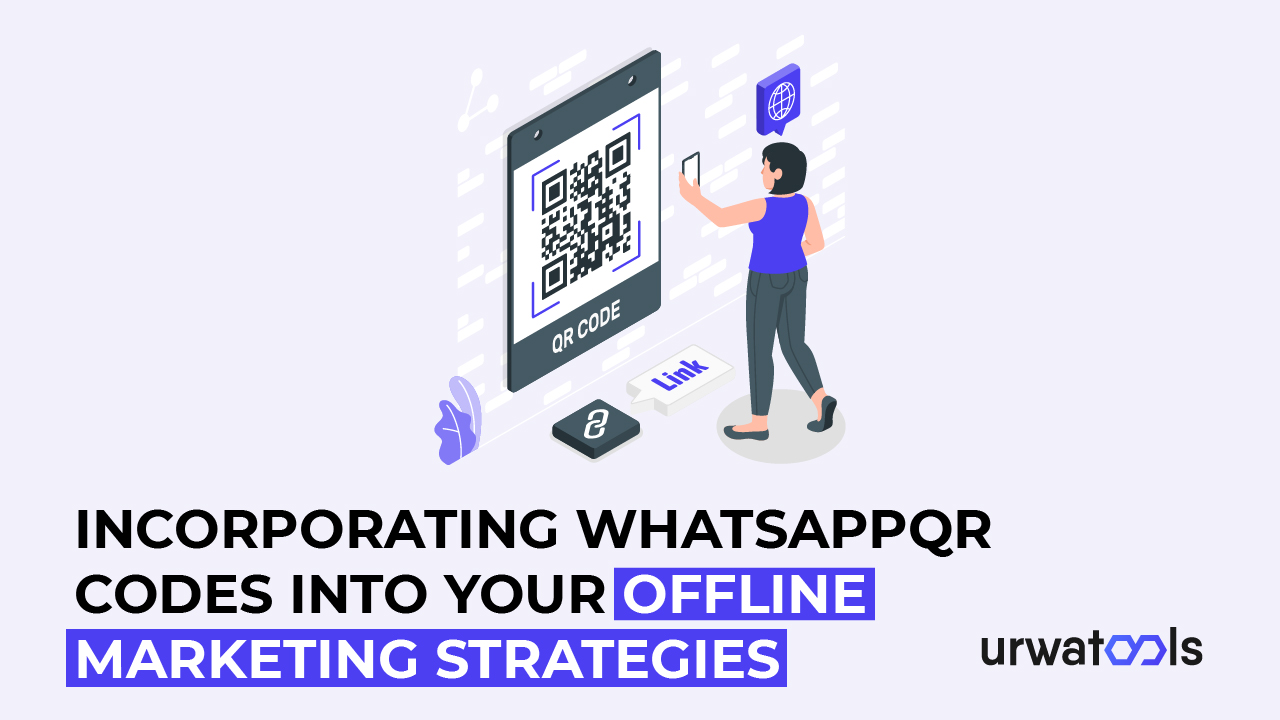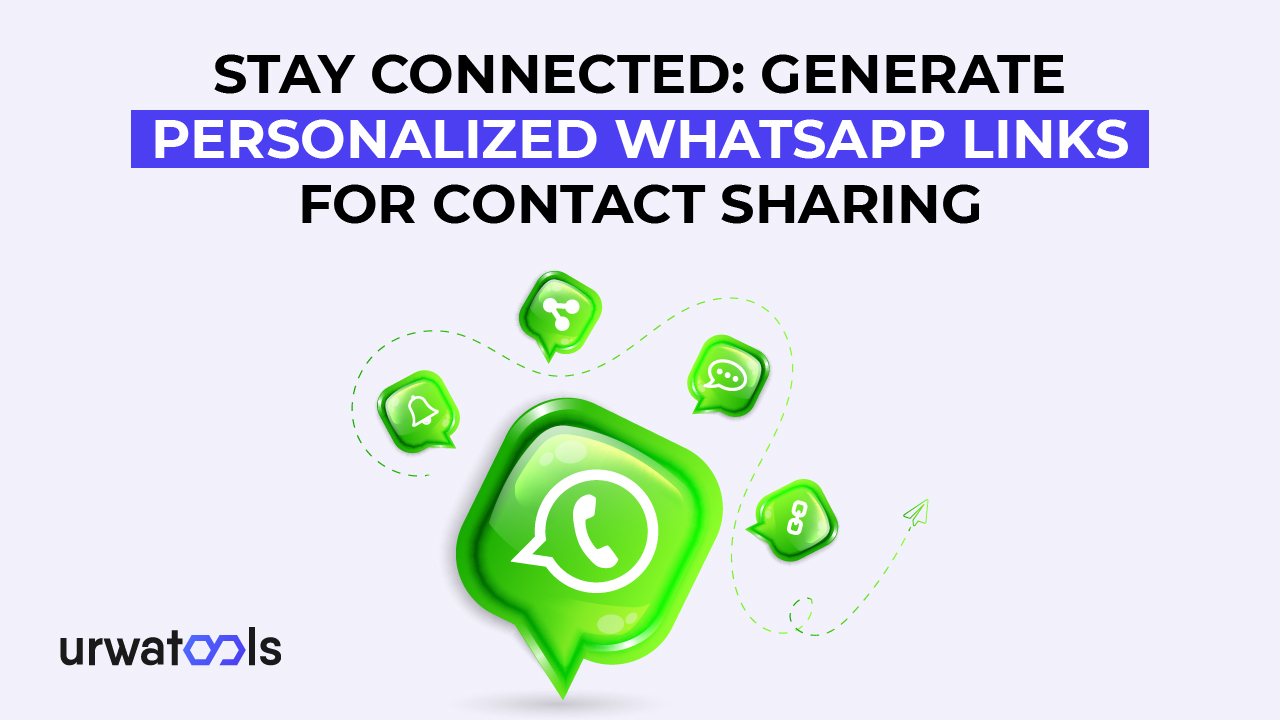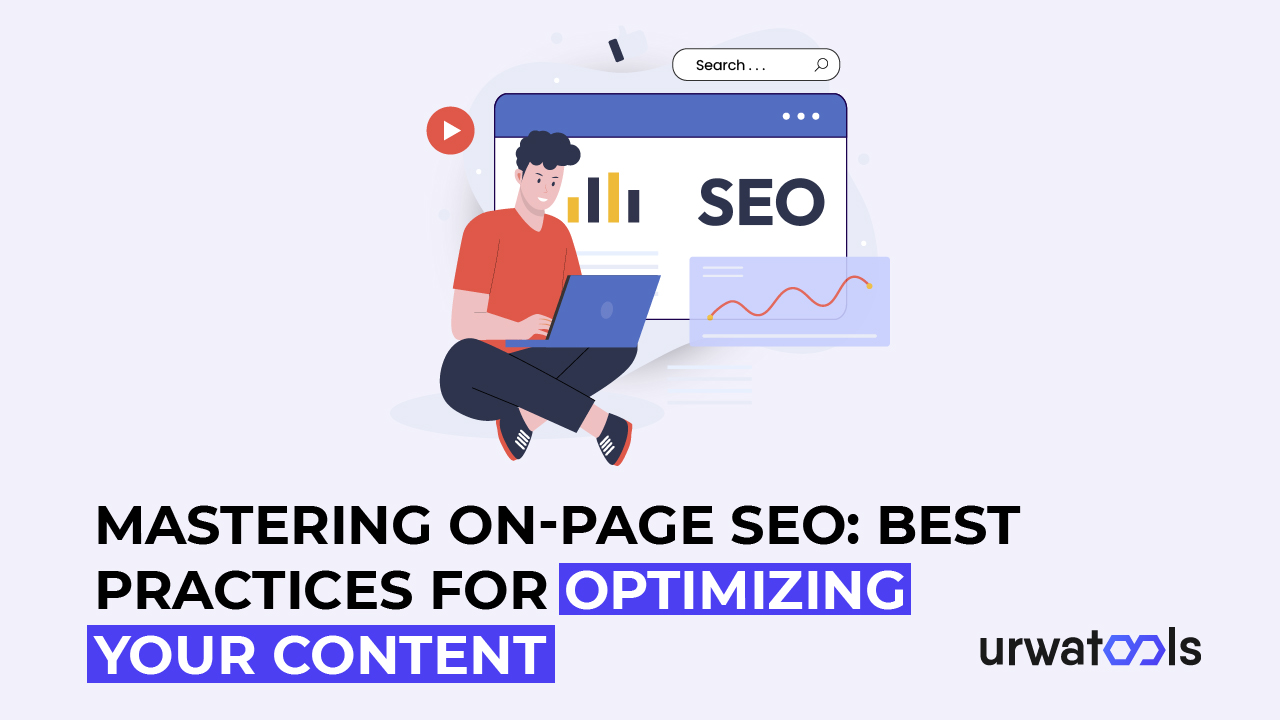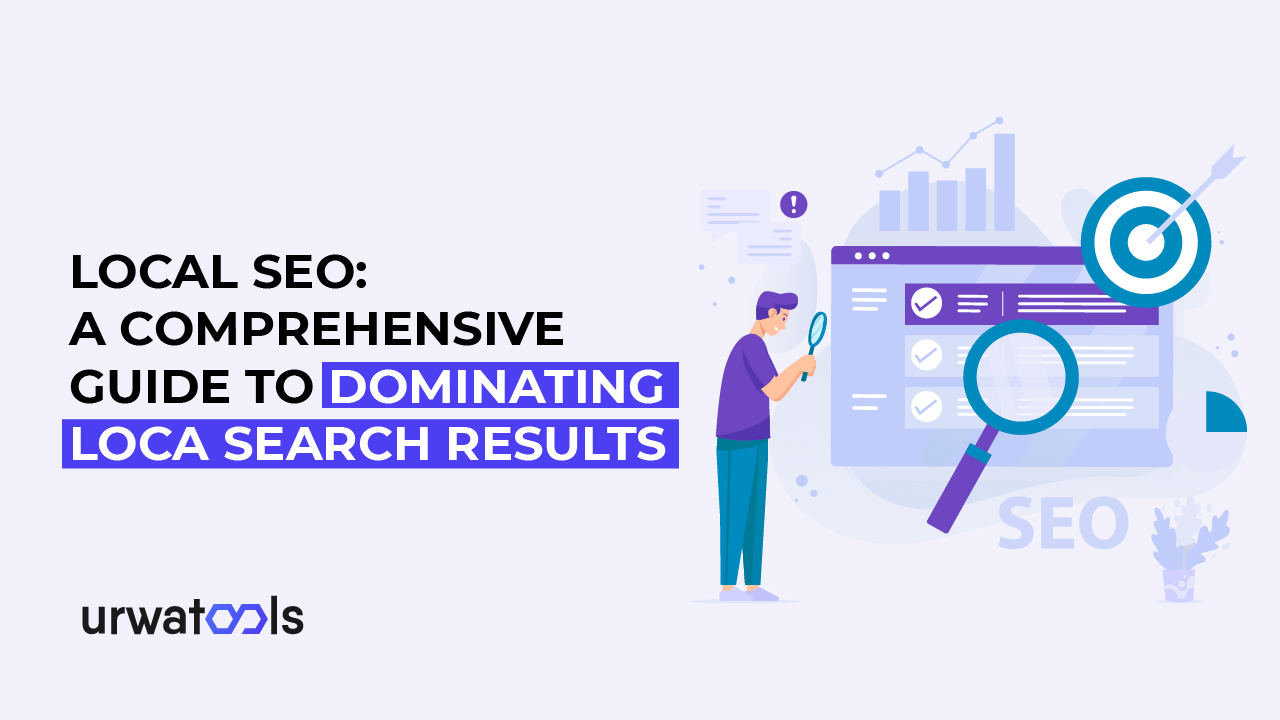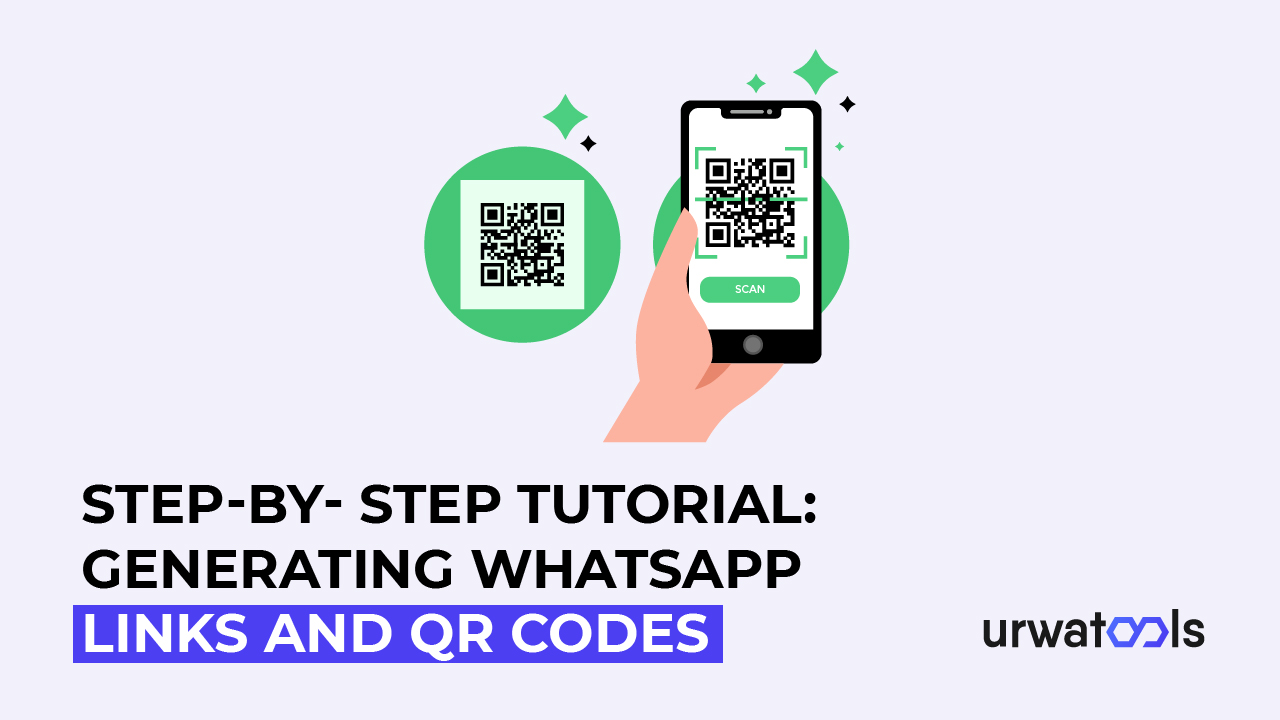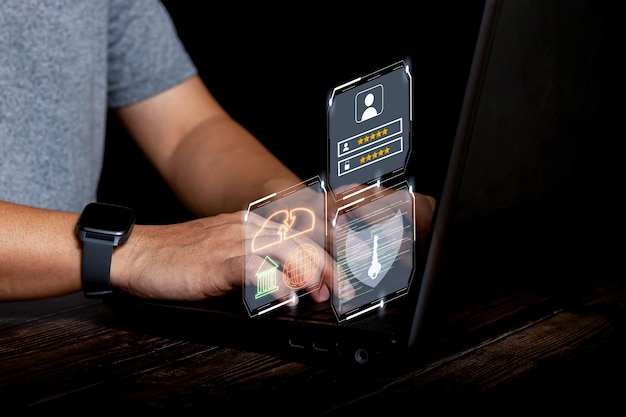آج کے ڈیجیٹل دور میں کاروبار آن لائن اور آف لائن مارکیٹنگ سرگرمیوں کے درمیان فرق کو ختم کرنے کے لئے جدید طریقوں کی تلاش کرتے ہیں۔ روایتی آف لائن مارکیٹنگ کے طریقے ، جیسے پرنٹ کولیٹرل ، بل بورڈز ، اور ان اسٹور پروموشنز ، اب بھی قیمتی ہیں۔ پھر بھی، صارفین کے بہتر تعامل کے لئے انہیں ڈیجیٹل پلیٹ فارم کے ساتھ مربوط کیا جانا چاہئے.
اپنی آف لائن مارکیٹنگ حکمت عملی میں واٹس ایپ کیو آر کوڈ شامل کرنا ایک بہترین طریقہ ہے۔ یہ پوسٹ واٹس ایپ کیو آر کوڈز کی صلاحیت کی کھدائی کرے گی اور آپ کو اپنے مارکیٹنگ اقدامات کو کامیابی سے فروغ دینے کے لئے ان سے فائدہ اٹھانے میں قیمتی بصیرت فراہم کرے گی۔
1. کیو آر کوڈز اور آف لائن مارکیٹنگ کی حکمت عملی کو سمجھنا
اس سے پہلے کہ ہم واٹس ایپ کیو آر کوڈز کو لاگو کرنے کے میکانکس کو سمجھیں ، انہیں سمجھنا ضروری ہے اور انہیں آف لائن مارکیٹنگ میں کس طرح استعمال کیا جاسکتا ہے۔ کیو آر کوڈ دو جہتی کوڈ ہیں جو اسمارٹ فون کے کیمرے یا ماہر کیو آر کوڈ ریڈر کا استعمال کرکے اسکین کیے جاسکتے ہیں۔ یہ کوڈ مختلف ڈیٹا رکھ سکتے ہیں ، بشمول یو آر ایل ، رابطے کی معلومات ، اور ایس ایم ایس پیغامات۔
آف لائن مارکیٹنگ کی حکمت عملی میں انٹرنیٹ میڈیا کے بغیر پروموشنل کارروائیاں شامل ہیں۔ پرنٹ میڈیا ، بل بورڈز ، براہ راست میل ، اور آمنے سامنے رابطے روایتی مارکیٹنگ کے طریقے ہیں۔ کاروبار اپنی آف لائن مارکیٹنگ سرگرمیوں میں کیو آر کوڈ شامل کرکے ، صارفین کی مصروفیت اور تبادلوں میں اضافہ کرکے اپنے آف لائن سامعین کو آن لائن پلیٹ فارمز کے ساتھ جوڑ سکتے ہیں۔
2. واٹس ایپ کیو آر کوڈ کی طاقت
فیس بک کے مشہور میسجنگ پروگرام واٹس ایپ نے کاروباری اداروں کے صارفین کے ساتھ منسلک ہونے کے طریقے کو تبدیل کر دیا ہے۔ واٹس ایپ، جس کے دنیا بھر میں 2 ارب سے زائد صارفین ہیں، کاروباری اداروں کو اپنے ہدف سامعین کے ساتھ بات چیت کرنے کے لئے ایک مکمل پلیٹ فارم فراہم کرتا ہے۔ آپ واٹس ایپ کی طاقت کا فائدہ اٹھا سکتے ہیں اور اپنی آف لائن مارکیٹنگ حکمت عملی میں واٹس ایپ کیو آر کوڈ شامل کرکے اس کے بے شمار فوائد حاصل کرسکتے ہیں۔
3. آف لائن مارکیٹنگ میں واٹس ایپ کیو آر کوڈ شامل کرنے کے فوائد
آف لائن مارکیٹنگ مہموں میں واٹس ایپ کیو آر کوڈ شامل کرنے سے کلائنٹ کی مصروفیت میں نمایاں اضافہ ہوسکتا ہے۔ واٹس ایپ کیو آر کوڈز کاروبار وں اور صارفین کے درمیان براہ راست مواصلاتی راستہ پیش کرکے ریئل ٹائم کنکشن اور ذاتی مواصلات کو ممکن بناتے ہیں۔
کاروبار واٹس ایپ کے ذریعے گاہکوں کے ساتھ بات چیت کرسکتے ہیں ، سوالات کے جوابات دے سکتے ہیں ، مصنوعات کی معلومات فراہم کرسکتے ہیں ، اور ذاتی تجاویز دے سکتے ہیں۔ یہ تعامل روایتی آف لائن مارکیٹنگ نقطہ نظر سے آگے پھیلا ہوا ہے ، جس سے فرموں کو کلائنٹ کنکشن کو مضبوط بنانے اور برانڈ وفاداری کو فروغ دینے میں مدد ملتی ہے۔
1. آسان اور ہموار تجربہ:
واٹس ایپ کیو آر کوڈ صارفین کو فوری اور ہموار تجربہ فراہم کرتے ہیں۔ صارفین بڑی محنت سے رابطے کی معلومات درج کرنے یا آن لائن کاروبار تلاش کرنے کے بجائے کیو آر کوڈ کو اسکین کرسکتے ہیں اور واٹس ایپ پر کمپنی کے ساتھ تیزی سے رابطہ قائم کرسکتے ہیں۔
صارفین کو اب متعدد ایپلی کیشنز یا پلیٹ فارمز کے درمیان منتقل کرنے کی ضرورت نہیں ہے ، مواصلات کو آسان بناتا ہے۔ گاہک آسانی سے مصنوعات کی معلومات تک رسائی حاصل کرسکتے ہیں، مدد حاصل کرسکتے ہیں، یا اسکین کے ساتھ سوالات کرسکتے ہیں. یہ آسانی گاہکوں کے تجربے کو بہتر بناتی ہے اور برانڈ کی شمولیت کو فروغ دیتی ہے۔
2. آف لائن سے آن لائن انضمام:
واٹس ایپ کیو آر کوڈ آف لائن اور آن لائن مارکیٹنگ اقدامات کو مربوط کرنے کے لئے ایک مؤثر تکنیک ہے۔ کاروبار پرنٹ اشتہارات ، بروشرز ، بل بورڈز ، یا مصنوعات کی پیکیجنگ جیسے آف لائن مواد میں کیو آر کوڈ شامل کرکے گاہکوں کو جسمانی سے ڈیجیٹل دنیا میں آسانی سے منتقل کرسکتے ہیں۔
یہ کنکشن فرموں کو روایتی اور آن لائن مارکیٹنگ پلیٹ فارم دونوں سے فائدہ اٹھانے کے قابل بناتا ہے۔ آف لائن مارکیٹنگ مواد ممکنہ گاہکوں کے لئے رابطے کا پہلا نقطہ ہیں، ان کی توجہ اپنی طرف مبذول کرتے ہیں. کیو آر کوڈ انٹرنیٹ پلیٹ فارمز کے لئے ایک پورٹل ہیں ، جو وسیع تعامل ، تبادلے کی نگرانی ، اور رہنمائی کی پرورش کی اجازت دیتا ہے۔
3. ذاتی مارکیٹنگ مہمات:
کاروبار ہر صارف کے لئے ذاتی مارکیٹنگ مہم تیار کرنے کے لئے واٹس ایپ کیو آر کوڈ استعمال کرسکتے ہیں۔ کاروبار صارف کے ڈیٹا جیسے پیشگی تعاملات یا خریداری کی تاریخ کو یکجا کرکے صارف کی ترجیحات اور دلچسپیوں پر منحصر مناسب پیغامات ، مصنوعات کی تجاویز ، یا خصوصی پیشکش فراہم کرسکتے ہیں۔
پرسنلائزیشن کی یہ ڈگری اداروں کو زیادہ متعلقہ اور بروقت معلومات پیش کرنے ، گاہکوں کے تجربے کو بہتر بنانے اور تبادلے کی شرح میں اضافہ کرنے کے قابل بناتی ہے۔ گاہکوں کو قابل قدر اور تعریف محسوس ہوتی ہے جب وہ ذاتی مواصلات حاصل کرتے ہیں، جس سے برانڈ کی وفاداری اور مصروفیت میں اضافہ ہوتا ہے.
4. قابل پیمائش نتائج اور تجزیات:
آف لائن مارکیٹنگ کے لئے واٹس ایپ کیو آر کوڈز کا ایک لازمی فائدہ مہمات کے اثرات کو ٹریک کرنا اور ان کا اندازہ لگانا ہے۔ واٹس ایپ کیو آر کوڈ اسکین، تعاملات اور تبادلوں کو ٹریک کرتا ہے۔
یہ ڈیٹا فرموں کو مہم کی کامیابی کا تجزیہ کرنے ، نمونوں کا پتہ لگانے اور مستقبل کی مارکیٹنگ کی کوششوں کے بارے میں اعداد و شمار پر مبنی فیصلے کرنے کے قابل بناتا ہے۔ کاروبار اپنی کوششوں کو بہتر بنا سکتے ہیں ، اپنے پیغام رسانی کو تبدیل کرسکتے ہیں ، اور نتائج کی نگرانی اور تجزیہ کرکے وسائل کو زیادہ موثر طریقے سے مختص کرسکتے ہیں۔
4. واٹس ایپ کیو آر کوڈ کیسے بنائیں
اپنی آف لائن مارکیٹنگ کی حکمت عملی میں واٹس ایپ کیو آر کوڈ شامل کرنے کے لئے، ان آسان اقدامات پر عمل کریں:
مرحلہ 1: واٹس ایپ بزنس ایپ کو اپ ڈیٹ کریں:
اس بات کو یقینی بنائیں کہ آپ کے اسمارٹ فون پر تازہ ترین واٹس ایپ بزنس ایپ انسٹال ہے۔ اگر نہیں تو ، متعلقہ ایپ اسٹور سے ایپ کو اپ ڈیٹ کریں۔
مرحلہ 2: کیو آر کوڈ کی خصوصیت تک رسائی حاصل کریں:
واٹس ایپ بزنس ایپ کھولیں اور ترتیبات کے سیکشن میں جائیں۔ "کیو آر کوڈ" آپشن تلاش کریں اور کیو آر کوڈ کی خصوصیت تک رسائی حاصل کرنے کے لئے اس پر ٹیپ کریں۔
مرحلہ 3: کیو آر کوڈ کو اپنی مرضی کے مطابق بنائیں اور ڈاؤن لوڈ کریں:
کیو آر کوڈ کی خصوصیت کے اندر ، آپ کیو آر کوڈ سے وابستہ کارروائیوں کو اپنی مرضی کے مطابق بنا سکتے ہیں۔ کیو آر کوڈ کو اپنی مرضی کے مطابق اور ڈاؤن لوڈ کرنے میں شامل ہیں:
• پہلے سے طے شدہ پیغام بھیجنا۔
• اپنے رابطے کی تفصیلات کا اشتراک.
• صارفین کو ایک مخصوص یو آر ایل پر ری ڈائریکٹ کرنا۔
ایک بار جب آپ کیو آر کوڈ کو اپنی مرضی کے مطابق بنا لیتے ہیں تو ، کیو آر کوڈ امیج کو محفوظ کرنے کے لئے "ڈاؤن لوڈ" بٹن پر ٹیپ کریں۔
5. آف لائن مارکیٹنگ میں واٹس ایپ کیو آر کوڈ استعمال کرنے کے تخلیقی طریقے
اب جب آپ واٹس ایپ کیو آر کوڈ تیار کرنے کے فوائد اور عمل کا احساس کرتے ہیں تو ، آئیے اپنی آف لائن مارکیٹنگ کی حکمت عملی وں میں انہیں استعمال کرنے کے کچھ طریقوں کو تلاش کریں:
1. کولیٹرل اور بزنس کارڈ پرنٹ کریں:
آف لائن مارکیٹنگ پرنٹ کولیٹرل جیسے بروشرز ، فلائیرز اور بزنس کارڈز پر بہت زیادہ انحصار کرتی ہے۔ آپ گاہکوں کو کوڈ اسکین کرنے اور ان مواد میں واٹس ایپ کیو آر کوڈ شامل کرکے فوری طور پر چیٹ شروع کرنے کی ترغیب دے سکتے ہیں۔ پرنٹ کولیٹرل اور بزنس کارڈ آپ کو مزید معلومات دینے، پوچھ گچھ کا جواب دینے، اور امکانات کو زیادہ موثر طریقے سے فروغ دینے کی اجازت دیتے ہیں.
2. اسٹور میں سائن ایج اور ڈسپلے:
خریداری کے دوران صارفین کو مشغول کرنے کے لئے ان اسٹور سائن بورڈ اور ڈسپلے پر واٹس ایپ کیو آر کوڈ استعمال کریں۔ آپ مصنوعات کے ڈسپلے کے قریب کیو آر کوڈ انسٹال کرسکتے ہیں تاکہ خریداروں کو مصنوعات کی خصوصیات کے بارے میں پوچھ گچھ کرنے کی اجازت مل سکے یا وہ دستیاب ہیں۔ آف لائن اور آن لائن چینلز کے درمیان ہموار لنک قائم کرنے کے لئے سائن ایج اور ڈسپلے اسٹور ، صارفین کے تجربے کو بہتر بناتا ہے۔
3. ایونٹ اور نمائش مارکیٹنگ:
تقریبات یا میلوں میں شرکت کرتے وقت ، واٹس ایپ کیو آر کوڈ لیڈ پیدا کرنے اور حاضرین کو مشغول کرنے کے لئے مفید ثابت ہوسکتا ہے۔ آپ لوگوں کو بینرز ، اشتہاری مواد ، یا یہاں تک کہ عملے کی وردی پر کیو آر کوڈ دکھا کر اضافی معلومات یا خصوصی رعایت کے لئے واٹس ایپ پر اپنے کاروبار سے جڑنے کی ترغیب دے سکتے ہیں۔ ایونٹ اور نمائش مارکیٹنگ آپ کو ایونٹ ختم ہونے کے بعد ممکنہ گاہکوں کے ساتھ براہ راست رابطہ قائم کرنے دیتی ہے۔
4. مصنوعات کی لیبلنگ اور پیکیجنگ:
صارفین خریداری کے بعد کی مدد، وارنٹی کی معلومات، یا مصنوعات کی رائے کے لئے مصنوعات کی پیکیجنگ یا لیبلز پر واٹس ایپ کیو آر کوڈ استعمال کرتے ہوئے آپ کی کمپنی سے رابطہ کرسکتے ہیں۔ مواصلات کی یہ کھلی لائن اعتماد کو فروغ دیتی ہے اور صارفین کے لئے سوالات یا شکایات کے ساتھ آپ تک پہنچنے کے لئے ایک آسان ذریعہ کے طور پر کام کرتی ہے۔
6. واٹس ایپ کیو آر کوڈ کے لئے بہترین طریقہ کار
اپنی آف لائن مارکیٹنگ کی حکمت عملی میں واٹس ایپ کیو آر کوڈ شامل کرتے وقت زیادہ سے زیادہ تاثیر کو یقینی بنانے کے لئے، مندرجہ ذیل بہترین طریقوں پر غور کریں:
1. اسے ظاہر اور قابل رسائی رکھیں:
واٹس ایپ کیو آر کوڈ کو نمایاں جگہوں پر رکھیں جہاں آپ کے ہدف کے سامعین انہیں دیکھ اور اسکین کرسکتے ہیں۔ اس بات کو یقینی بنائیں کہ وہ پرنٹ مواد ، اشارے ، اور دیگر آف لائن مارکیٹنگ وسائل پر نظر آتے ہیں۔
2. اسکیننگ کی ترغیبات فراہم کریں:
انعامات اور خصوصی پروموشنز حاصل کرنے کے لئے اپنے واٹس ایپ کیو آر کوڈ کو اسکین کریں۔ اسکیننگ ترغیبات میں رعایت ، مفت ، یا خصوصی مواد تک رسائی شامل ہوسکتی ہے۔ ترغیبات صارفین کی شمولیت اور کوڈ اسکیننگ کے امکانات کو بڑھاتی ہیں۔
3. ٹیسٹ اور بہتری:
واٹس ایپ کے کئی قسم کے کیو آر کوڈز کو باقاعدگی سے ٹیسٹ کریں اور ان کی کامیابی کو ٹریک کریں۔ اسکین ، مصروفیت کی شرح ، اور تبادلوں پر نظر رکھیں تاکہ اس بات کی نگرانی کی جاسکے کہ آپ کے ہدف ڈیموگرافک کے لئے کیا بہترین کام کرتا ہے۔ اپنی کیو آر کوڈ مہمات کو بہتر بنانے کے لئے اس معلومات کا استعمال کریں اور وقت کے ساتھ نتائج میں اضافہ دیکھیں۔
4. دیگر مارکیٹنگ چینلز کے ساتھ ضم کریں:
دوسرے مارکیٹنگ چینلز جیسے سوشل میڈیا ، ای میل نیوز لیٹر ، اور ڈیجیٹل اشتہارات میں واٹس ایپ کیو آر کوڈ شامل کریں۔ آپ صارفین کو کیو آر کوڈ اسکین کرنے کے لئے متعدد ٹچ پوائنٹس پیش کرکے اپنے ہدف ڈیموگرافک کے ساتھ نمائش اور تعامل کو فروغ دے سکتے ہیں۔
7. کامیابی کی کہانیاں: آف لائن مارکیٹنگ میں واٹس ایپ کیو آر کوڈز کی اصل کیس اسٹڈیز
آئیے دو حقیقی زندگی کی کامیابی کی مثالوں پر نظر ڈالتے ہیں جو آف لائن مارکیٹنگ کی حکمت عملی کے لئے واٹس ایپ کیو آر کوڈ کی طاقت کو ظاہر کرتی ہیں:
1. کیس اسٹڈی 1: ایکس وائی زیڈ ریٹیل اسٹور:
ایکس وائی زیڈ ریٹیل اسٹور پر پروڈکٹ پیکیجنگ پر واٹس ایپ کیو آر کوڈ استعمال کیے گئے۔ کوڈ کو اسکین کرنے والے صارفین کو واٹس ایپ پر ہونے والی گفتگو میں لے جایا گیا جہاں وہ مصنوعات کے استعمال کے بارے میں پوچھ گچھ کرسکتے ہیں، سفارشات کی درخواست کرسکتے ہیں یا تبصرے فراہم کرسکتے ہیں۔ اس کوشش نے صارفین کی پوچھ گچھ میں 30٪ اضافہ کیا اور ڈرامائی طور پر گاہکوں کے اطمینان کے اسکور کو بہتر بنایا.
کیس اسٹڈی 2: اے بی سی ریستوراں:
اپنے ڈائن ان مینو پر ، اے بی سی ریستوراں واٹس ایپ کیو آر کوڈ استعمال کرتا ہے۔ صارفین واٹس ایپ کے ذریعے کوڈ اسکین کرکے، کاغذی مینو کو ختم کرکے اور کانٹیکٹ لیس کھانے کے تجربے کو بہتر بنا کر آرڈر دے سکتے ہیں۔ اس طریقہ کار نے آرڈر دینے کے طریقہ کار کو آسان بنا دیا اور ریستوراں کو ذاتی پیشکشوں اور مستقبل کے مارکیٹنگ اقدامات کے لئے صارفین کا ڈیٹا جمع کرنے کی اجازت دی۔
8. چیلنجز اور حل
صارف کو اپنانا اور آگاہی
آف لائن مارکیٹنگ کی حکمت عملی میں واٹس ایپ کیو آر کوڈ شامل کرتے وقت کاروباری اداروں کو درپیش چیلنجوں میں سے ایک صارف کو اپنانا اور آگاہی ہے۔ اگرچہ کیو آر کوڈز نے حال ہی میں مقبولیت حاصل کی ہے ، لیکن تمام صارفین تصور یا انہیں اسکین کرنے کا طریقہ نہیں جانتے ہیں۔
اس چیلنج پر قابو پانے کے لئے، کاروبار کئی اقدامات کر سکتے ہیں:
تفصیلی ہدایات اور تعلیم: واٹس ایپ کیو آر کوڈ اسکین کرنے کے لئے تفصیلی ہدایات فراہم کریں اور اپنے ہدف سامعین کو اسکیننگ کے فوائد کے بارے میں تعلیم دیں۔ ہدایات اور تعلیم تعلیمی فلموں ، قدم بہ قدم ہدایات ، یا گرافک نمائندگی کے ذریعہ حاصل کی جاسکتی ہیں۔ آپ صارفین کی حوصلہ افزائی کر سکتے ہیں کہ وہ عمل کو واضح کرکے اور حاصل کردہ قدر پر زور دے کر کیو آر کوڈز کو گلے لگائیں اور ان کے ساتھ بات چیت کریں۔
2. بصری اشارے: کیو آر کوڈ کے ارد گرد تیر یا شبیہیں جیسے بصری اشارے استعمال کریں تاکہ یہ تجویز کیا جاسکے کہ کوڈ کو اسکین کرنے سے اضافی معلومات یا خصوصی سودے ہوں گے۔ یہ اشارہ صارفین کی دلچسپی کو بڑھا سکتا ہے اور انہیں کوڈ اسکین کرنے کی ترغیب دے سکتا ہے۔
انعامات کی اسکیننگ: کیو آر کوڈ کو اسکین کرنے کے لئے انعامات فراہم کریں ، جیسے منفرد ڈسکاؤنٹ یا خصوصی مواد تک رسائی۔ زیادہ تر گاہک ممکنہ طور پر کوڈ کے ساتھ بات چیت کریں گے اور فوری فائدہ پیش کرکے کسی بھی ابتدائی مزاحمت پر قابو پائیں گے۔
2) تکنیکی مسائل
جب صارفین واٹس ایپ کیو آر کوڈ اسکین کرتے ہیں تو ، تکنیکی مشکلات جیسے ڈیوائس کی مطابقت یا کیو آر کوڈ ریڈر ایپ کی مطابقت پیدا ہوسکتی ہے۔ یہ مشکلات ہموار تجربے میں رکاوٹ پیدا کرتی ہیں اور لوگوں کو مزید بات چیت کرنے سے روکتی ہیں۔
ان تکنیکی چیلنجوں سے نمٹنے کے لئے، کاروبار مندرجہ ذیل حل پر غور کر سکتے ہیں:
1. ٹیسٹ مطابقت: ہموار اسکیننگ کی ضمانت دینے کے لئے، متعدد آلات اور پلیٹ فارمز میں کیو آر کوڈ کی مطابقت کی جانچ کریں. ٹیسٹ مطابقت میں عام اینڈروئیڈ اور آئی او ایس ڈیوائسز پر ٹیسٹنگ اور مختلف کیو آر کوڈ ریڈر سافٹ ویئر کا استعمال شامل ہے۔
2. تکنیکی چیلنجوں کے لئے شرکت کے متبادل ذرائع تلاش کرنے میں صارفین کی مدد کریں. مثال کے طور پر ، لوگوں کو ٹیکسٹ پر مبنی یو آر ایل یا شارٹ کوڈ دیں جسے لوگ واٹس ایپ پر آپ کی کمپنی سے رابطہ کرنے کے لئے دستی طور پر اپنے میسجنگ پروگرام میں ٹائپ کرسکتے ہیں۔
3) ڈیٹا پرائیویسی اور سیکیورٹی:
آف لائن مارکیٹنگ کی کوششوں میں واٹس ایپ کیو آر کوڈ ز کو لاگو کرتے وقت ، فرموں کو کلائنٹ کے ڈیٹا کو احتیاط سے لینا چاہئے اور ڈیٹا کے تحفظ کے معیارات پر عمل کرنا چاہئے۔ ڈیٹا کی رازداری اور سلامتی کو برقرار رکھنا صارفین کے اعتماد کے لئے اہم ہے۔
ڈیٹا کی رازداری اور سیکورٹی خدشات کو حل کرنے کے لئے، مندرجہ ذیل اقدامات پر غور کریں:
1. اپنی ڈیٹا پرائیویسی پالیسی سے رابطہ کریں: صارفین کو کیو آر کوڈ اسکین کرنے سے پہلے ، اپنی رازداری کی پالیسی سے بات چیت کریں۔ وضاحت کریں کہ ان کا ڈیٹا کس طرح جمع کیا جائے گا، ذخیرہ کیا جائے گا، اور استعمال کیا جائے گا، اور انہیں ان کی رازداری کے حقوق اور حفاظتی احتیاطی تدابیر کی یقین دہانی کرائیں.
2. منظوری حاصل کریں: کیو آر کوڈ کے ذریعے ذاتی معلومات جمع کرنے سے پہلے، صارفین سے واضح منظوری حاصل کریں. منظوری حاصل کرنے کے لئے رضامندی چیک باکس یا آپٹ ان پیغام کا استعمال کیا جاسکتا ہے جو ڈیٹا جمع کرنے سے پہلے ظاہر ہوتا ہے۔
3. محفوظ ڈیٹا اسٹوریج: کلائنٹ کی معلومات کو غیر مجاز رسائی سے محفوظ رکھنے کے لئے محفوظ ڈیٹا اسٹوریج طریقوں کا استعمال کریں. یہ کہ آپ کا سسٹم تازہ ترین سیکیورٹی طریقہ کار کے ساتھ تازہ ترین ہے اور آپ باقاعدگی سے اپنے ڈیٹا ہینڈلنگ آپریشنز کا آڈٹ اور نگرانی کرتے ہیں۔
کاروبار ان رکاوٹوں کو دور کرکے اور پیش کردہ حل وں کو لاگو کرکے صارف کی افزائش ، تکنیکی مسائل اور ڈیٹا پرائیویسی کی رکاوٹوں پر قابو پاسکتے ہیں۔ ڈیٹا اسٹوریج کو محفوظ بنانے سے واٹس ایپ کیو آر کوڈز کو آف لائن مارکیٹنگ کی کوششوں میں آسان اور مؤثر انضمام میں مدد ملے گی، جس سے کاروباری اداروں اور صارفین کے لئے ہموار اور محفوظ تجربے کو یقینی بنایا جاسکے گا۔
یاد رکھیں ، واٹس ایپ کیو آر کوڈ مہمات کی مسلسل نگرانی کرنا اور صارفین سے رائے اکٹھا کرنا ضروری ہے۔ یہ آپ کو دوبارہ بہتری لانے اور اپنی حکمت عملی کو بہتر بنانے کی اجازت دے گا. یہ آپ کی آف لائن مارکیٹنگ کی کوششوں میں واٹس ایپ کیو آر کوڈ کے فوائد کو زیادہ سے زیادہ کرے گا۔
9. کامیاب واٹس ایپ کیو آر کوڈ مہم کے لئے تجاویز
اپنی واٹس ایپ کیو آر کوڈ مہم کی تاثیر کو زیادہ سے زیادہ کرنے کے لئے، مندرجہ ذیل تجاویز پر غور کریں:
1. قدر کی تجویز کی وضاحت کریں:
اپنے واٹس ایپ کیو آر کوڈ کی مارکیٹنگ کرتے وقت یہ واضح کریں کہ صارفین کو اسے اسکین کرکے کیا ملے گا۔ انہیں فوری مواصلات، غیر معمولی سودے، یا ذاتی مدد کے فوائد سے آگاہ کریں.
2. اس لفظ کو متعدد چینلوں کے ذریعے پھیلائیں:
اپنے واٹس ایپ کیو آر کوڈ ایڈورٹائزنگ کو ایک چینل تک محدود نہ کریں۔ برانڈ کے بارے میں آگاہی پیدا کرنے کے لئے بڑے سامعین تک پہنچنے کے لئے سوشل میڈیا ، ای میل نیوز لیٹرز ، ویب سائٹ بینرز ، اور آف لائن پرنٹ مواد جیسے مختلف مارکیٹنگ پلیٹ فارمز کا استعمال کریں۔
3. دلکش ترغیبات پیش کریں:
صارفین کو اپنے واٹس ایپ کیو آر کوڈ کو اسکین کرنے کے بدلے منفرد ڈسکاؤنٹ، خصوصی پروموشنز، یا اہم مواد تک رسائی کی پیش کش کریں۔ صارفین کو یہ احساس دلائیں کہ وہ واٹس ایپ پر آپ کے برانڈ کے ساتھ بات چیت کرکے کچھ اہم حاصل کر رہے ہیں۔
4. کارکردگی پر نظر رکھیں اور تجزیہ کریں:
اپنے واٹس ایپ کیو آر کوڈ مہم کی کارکردگی کی باقاعدگی سے نگرانی کریں۔ اسکین ، مصروفیت کی شرح ، اور تبادلوں پر نظر رکھیں۔ نمونوں کی نشاندہی کرنے ، مہمات کو بہتر بنانے ، اور مستقبل کے مارکیٹنگ منصوبوں کے بارے میں اعداد و شمار پر مبنی فیصلے کرنے کے لئے اعداد و شمار کا تجزیہ کریں۔
5. باقاعدگی سے ٹیسٹ اور آپٹمائز کریں:
اپنے واٹس ایپ کیو آر کوڈ کے لئے متبادل ڈیزائن ، جگہ ، اور پروموشنل ٹیکسٹ کے ساتھ تجربہ کریں۔ مختلف ترغیبات کی جانچ کریں اور کارروائی کے لئے کال کریں تاکہ یہ معلوم کیا جاسکے کہ آپ کو اپنے ہدف کے سامعین کے لئے مطلوبہ نتائج کیا ملتے ہیں۔ وقت کے ساتھ ساتھ اس کی تاثیر کو بڑھانے کے لئے اپنی مہم کو باقاعدگی سے بہتر بنائیں۔
10. نتیجہ
آخر میں ، آف لائن مارکیٹنگ میں واٹس ایپ کیو آر کوڈ شامل کرنے سے اداروں کو کلائنٹ کنکشن کو بہتر بنانے ، جسمانی اور ڈیجیٹل تقسیم کو ختم کرنے اور ذاتی تجربات پیدا کرنے کی زبردست صلاحیت ملتی ہے۔ کاروباری ادارے واٹس ایپ پر صارفین کے ساتھ بات چیت کرسکتے ہیں ، قریبی رابطے قائم کرسکتے ہیں ، اور کیو آر کوڈ کی سادگی اور ہموار فطرت کا استعمال کرتے ہوئے برانڈ وفاداری کو فروغ دے سکتے ہیں۔ مہم کی تاثیر کا سراغ لگانا اور اس کا اندازہ لگانا حکمت عملی کو بہتر بنانے اور وسائل مختص کرنے کے لئے مفید اعداد و شمار فراہم کرتا ہے۔ واٹس ایپ کیو آر کوڈ ڈیجیٹل دور میں آف لائن مارکیٹنگ سرگرمیوں کو زیادہ سے زیادہ کرنے کے لئے ایک مؤثر آلہ ہے۔ وہ بڑھتی ہوئی مصروفیت ، ذاتی مارکیٹنگ ، اور آف لائن سے آن لائن رابطے جیسے فوائد پیش کرتے ہیں۔

